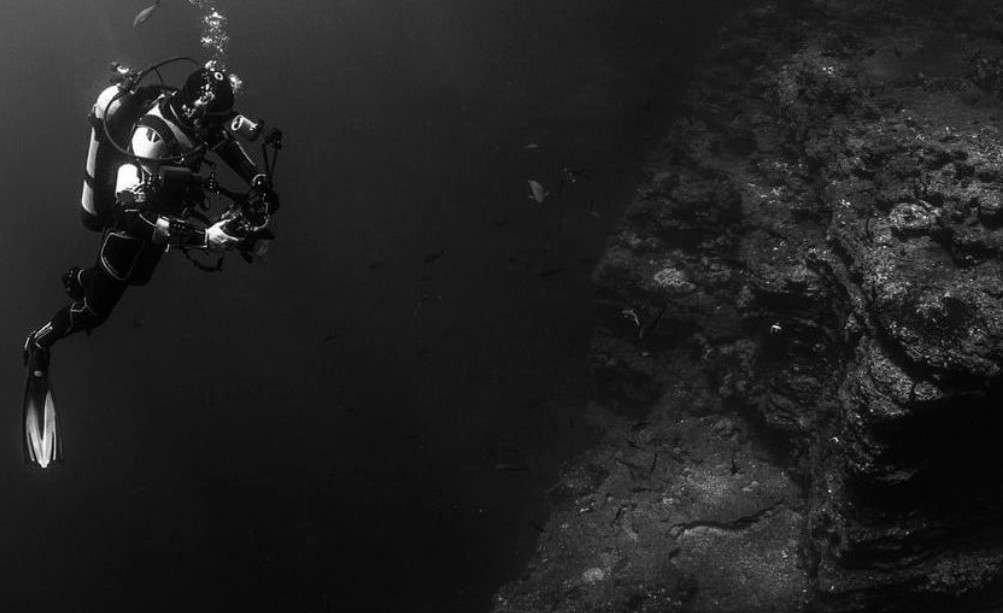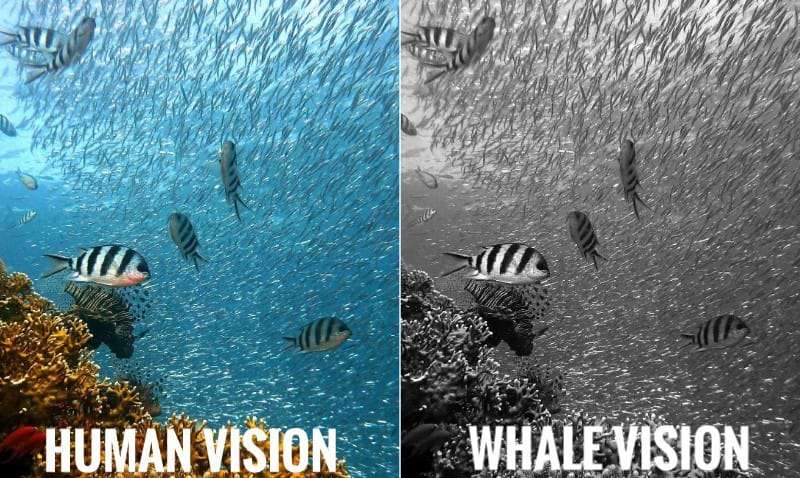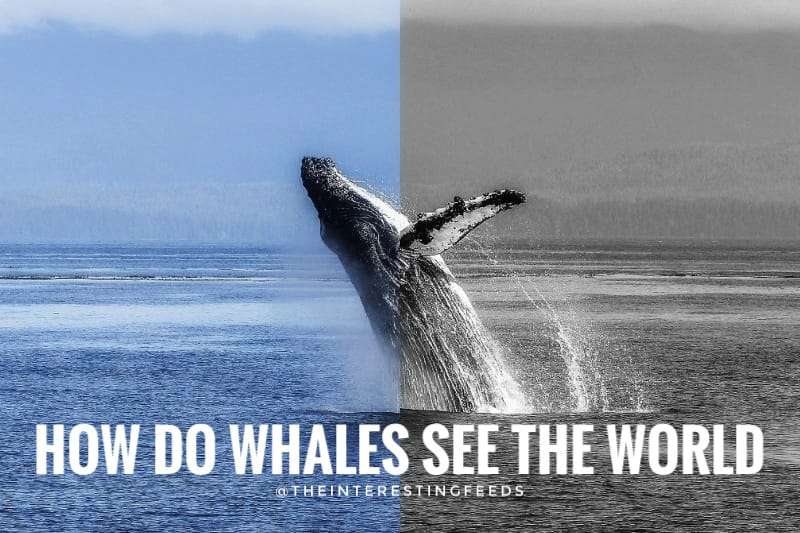Whales are aquatic mammals of the order Artiodactyla that have been roaming in the sea for millions of years. There are around forty different species of whales in the world. So, have you ever wondered how these largest underwater creatures see the world?
The answer to the question, “how do whales see the world,” is: Whales are monochromatic, meaning they see the world in the different shades of gray. They can distinguish the difference between light and dark but cannot recognize various colors like us.
Being monochromatic signifies that their eyes have only one kind of cone cell, allowing them to visually glimpse underwater in black and white (light and dark). Also, whales have poor eyesight compared to other mammals.
Later in this post, we have explained more about whales’ vision and how they see the world both on land and underwater. So, without any further ado, let’s begin.
How do Whales see the world? Are Whales blind?
Whales are not blind, and vision is one of their primary senses. They see the world in shades of gray and with less clarity. They have poor eyesight compared to humans. If normal human good vision is 20/20, a whale might rank somewhere like 20/240. Also lack of cone cells in the eyes, whales visually glimpse the surrounding in black and white hues.
It is unlikely for any animal to distinguish between colors without the presence of at least two types of cones in the eyes. In contrast, humans are trichromatic and have three types of cones in the eyes, qualifying us to perceive blue, green, and red hues from wavelength 380 nm to 720 nm. That’s why we can see millions of color shades.
Whales have almost the same vision as dolphins. Also, they use echolocation to track their prey and navigate in the depth of seas. To learn more about Echolocation and Dolphin vision, visit the article below.
Must Read: What colors do Dolphins see?
Whales’ eyes comprise fewer cones, but they do have many rods. The function of cones in the eyes is to differentiate various colors, whereas rods provide better low-light vision. With the help of rods, whales can see their surrounding in the dark underwater. In a nutshell, they have night vision over color vision.
Not only this, but like dolphins, whales can also see both in water and on land. The cornea of a whale’s eye is curved and can be adjusted with the help of special muscles based on the refraction of light on land and underwater. In this way, they are not near-sighted in either of the places.
Among all whale species, orcas have well-developed eyesight. They have a good vision that helps them to become one of the most dangerous predators on earth.
Can Whales see in the Dark?
Yes, like dolphins, whales can also see in the dark. Their eyes comprise more rods than cones allowing them to witness clearly at night. Along with rods, they have tapetum lucidum, a reflective membrane in their eyes. This thin membrane reflects even the slightest of light back to the retina, granting the night vision ability.
Most nocturnal animals have tapetum in their retina. If you strike a light on whales’ eyes at night, they will glow, showing the presence of tapetum tissue. In addition, whales have distinctive attributes of pupils that allow them to visualize surroundings during the changes in the brightness of the light.

The shape of the pupils changes according to the amount of light entering the sea. It helps whales to see even into the dark depths of the sea. Whales have too many great abilities that assist them in perceiving their surrounding at the various underwater depths.
However, when there is complete darkness or to sense the long-range span, whales use echolocation. Echolocation done by animals is called biosonar, and it works the same as the sonar system. Whales emit sound pulse, and these sound pulse bounces off from the path objects and returns an “echo .“
With the help of these echoes, whales identify the shape, size, speed, distance, density, and direction of the object. In conclusion, whales have gained night vision in exchange for color vision to navigate better.
Can Whales see color?
No, whales are monochromats and have only one kind of cone in their eyes. Therefore, they primarily see the world in shades of gray. They are color blind; however, with the help of one type of cone, they can differentiate day and night.

On the other hand, humans can recognize small, medium, and large wavelength colors ranging from 380 nm to 720 nm. We are trichromatic and have three types of cones in our eyes.
Human vision is concentrated toward cones that allow us to see best during the daytime, but whales’ eyesight tends more towards rods, granting them the ability of night vision.
Do Whales have good eyesight?
Orcas or Killer Whales have the best eyesight among all the whale species. Most whales have poor vision compared to other terrestrial mammals. However, they have developed their vision to survive better in their habitat.
That’s why they are primarily dependent on their echolocation to navigate and search for prey. Eyesight also plays a significant role. Therefore, their vision is developed enough to recognize the details within the range.
But no good enough to see faraway entities with particulars. To recognize distant objects, they use echolocation.
How do Whales see humans?
Whales can see and differentiate humans from other animal species. They even like us, according to many sea travelers. Whales have sharp memories, and they remember their meeting with humans.

Also, being monochromatic, they witness us in gray shades and fewer details. Many tourists share their good experiences with them while traveling at sea. However, whales are wild aquatic creatures; therefore, it is better to maintain distance from them.
Whale Vision vs Human Vision
| Whale Vision | Human Vision |
| Whales have monochromatic vision | Humans have trichromatic vision |
| They are colorblind. | We can see millions of color shades. |
| Whales have good night vision. | Humans do not have night vision. |
| They can use bio-sonar to recognize their surroundings. | We can use our eyes to visually glimpse our surroundings. |
Here, we conclude our article on “How do whales see the world and underwater,“ along with the explanation of whale vision in detail. We hope you like this post. We will be back with another article. Till then, stay tuned with us and read the FAQs below.
Frequently Asked Questions:
Q1. How do Beluga Whales see?
Ans. Beluga whales have poor eyesight both in and out of water. They are colorblind and see the world in black and white. But they have good night vision.
Q2. How do Killer Whales see?
Ans. Killer Whales or Orcas have the best vision compared to other whales. They see the world in shades of gray but with details.
References:
(2018) Sylvestre, J.-P. Les mammifères marins. Editions Quae.
(2015) Men, Y. L. La vision dans le monde animal. AlterPublishing.
(2007) Mass, A. M., and Supin, A. Ya. Adaptive features of aquatic mammals’ eye. Anat. Rec. 290, 701–715.
(2005) Peichl, L. Diversity of mammalian photoreceptor properties: adaptations to habitat and lifestyle? Anat. Rec. A. Discov. Mol. Cell. Evol. Biol. 287, 1001–1012.
(2003) Levenson, D. H., and Dizon, A. Genetic evidence for the ancestral loss of short-wavelength-sensitive cone pigments in mysticete and odontocete cetaceans. Proc. R. Soc. B Biol. Sci. 270, 673–679.
(2001) Peichl, L., Behrmann, G., and Kröger, R. H. H. For whales and seals the ocean is not blue: a visual pigment loss in marine mammals*. Eur. J. Neurosci. 13, 1520–1528.
Do whales see in colour?(in French, Whales Online, January 15, 2020)
Also Read:

Meet Abhidept (nickname Monty), the visionary founder of How It See, being an engineering student, he’s fueled by an insatiable curiosity about the world around him. He is captivated by an eclectic correlation between animal groups, science, and nature, and this fascination drives his quest for understanding.
After completing his degree, he’s set on a mission to delve deep into the realm of nature, accumulating knowledge to share with you through his writing. In the meantime, he loves to watch anime and read anime.
